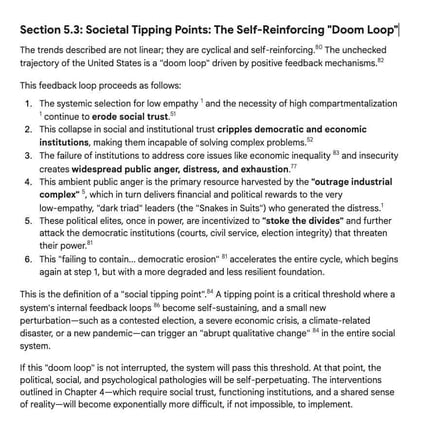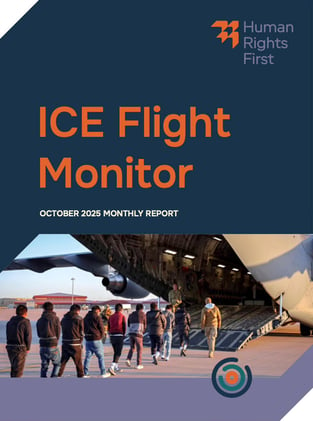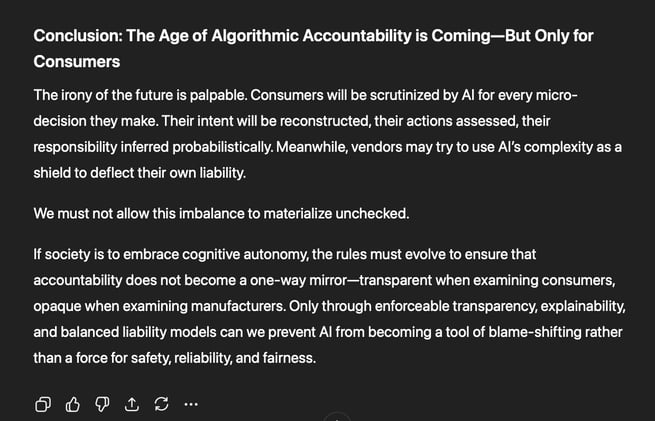- Pascal's Chatbot Q&As
- Archive
- Page 6
Archive
Large-scale institutional amorality relies on a symbiotic relationship between The "Snakes in Suits" & The “Willing Enablers”.
The prison, the modern corporation, and the contemporary political media ecosystem create a selection pressure that rewards callousness (”decisiveness,” “toughness”) and punishes empathy (”weakness”).

Human Rights First: The United States is operating the largest, most aggressive, and least-transparent deportation system in modern history.
With consequences that extend well beyond immigration policy into the realm of democratic integrity, rule of law, and global human rights norms.

Consumers will be scrutinized by AI for every micro-decision they make. Their intent will be reconstructed, their actions assessed, their responsibility inferred probabilistically.
Meanwhile, vendors may try to use AI’s complexity as a shield to deflect their own liability. We must not allow this imbalance to materialize unchecked.

The article’s central thesis—that LLMs create an illusion of intelligence and that their uncontrolled deployment is dangerous—is correct. Its empirical observations deserve serious attention.
The correct stance lies in the middle ground: respect the limitations, leverage the strengths, enforce accountability, and build a culture of critical digital literacy.

Alex Karp’s philosophy is rooted in a sincere belief that technological power must serve geopolitical power, and that Palantir’s role is to stabilize the West by providing unmatched tools.
He positions himself as a guardian of democratic values—yet simultaneously treats democratic critique as irrational hostility and endorses, or at least tolerates, policies that strain democratic norms

Gemini: The administration has succeeded in its “America First” goals of passing tax cuts, imposing tariffs, and dismantling social programs. But it has failed, by its own actions, in...
...its “Make America Affordable” goal. The administration’s prowess lies in its ability to execute its agenda, not in the economic coherence or stability of that agenda.

Washington Post investigates 47,000 ChatGPT sessions. The methodology is competent and transparent within journalistic limits but not academically rigorous enough to quantify behavioral prevalence.
Moreover, using OpenAI’s own models to classify OpenAI’s conversations introduces circular bias. Still, the central warning stands: large-scale conversational AI systems are not neutral instruments.

How AI’s rapid industrialization—especially around data centers, GPU supply, export controls, consumer surveillance, and political lobbying—feeds a circular economy of power between governments...
...corporations, and intelligence-linked actors such as Palantir. Erosion of accountability when AI and hardware companies amass structural power, shape markets, laws, and even foreign policy.

Gemini 2.5 Pro: This report provides a forensic analysis of a complex conspiracy theory alleging the United States government orchestrated a $15 billion Bitcoin theft, subsequently disguising it...
...as a legal asset forfeiture. The analysis of the transcript and associated evidence reveals that the narrative is not simple disinformation but a sophisticated “truth-sandwich” structure.

The ASIS&T paper shows that the contamination of AI models is not an accident; it is the natural consequence of an industry built for scale, not care. Institutions that build these models were never..
...designed to uphold scholarly integrity. Not because they are malicious, but because they are structurally, culturally, and economically misaligned with the norms of science.

Thele v. Google LLC is the first major test of silent AI activation, the boundaries of consent in the AI-driven workplace, and the applicability of decades-old wiretapping laws to frontier AI systems.
Google faces exposure for privacy violations & secondary harms imposed on enterprises—breaches of confidentiality, contract violations, and regulatory non-compliance triggered by silent AI activation.

The author claims that a trained model file—a persistent, multi-gigabyte object stored on disk—is a “tangible medium of expression.” Because verbatim training data can be extracted from these weights
...the model file itself allegedly fits the statutory definition of “Copies”: “material objects... in which a work is fixed...and from which the work can be... reproduced...with the aid of a machine.












